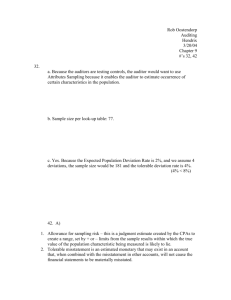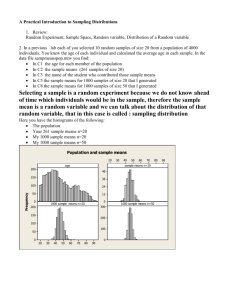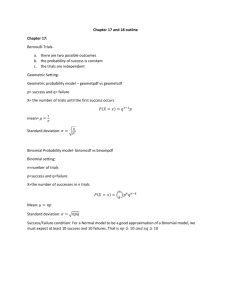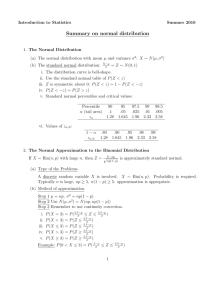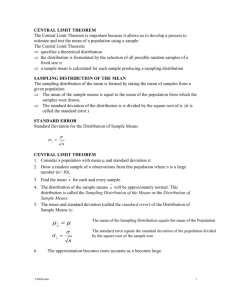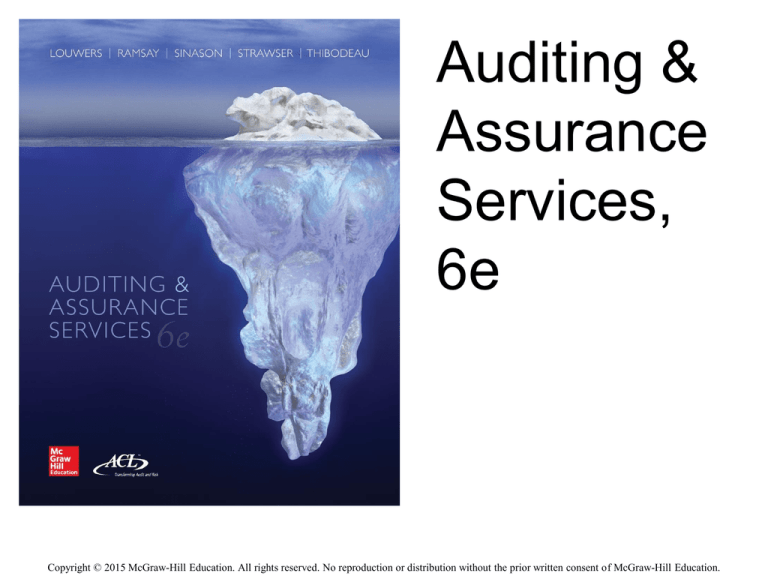
Auditing &
Assurance
Services,
6e
Copyright © 2015 McGraw-Hill Education. All rights reserved. No reproduction or distribution without the prior written consent of McGraw-Hill Education.
Module F
Attributes Sampling
There are five kinds of lies: lies, damned lies, statistics, politicians
quoting statistics, and novelists quoting politicians on statistics.
Stephen K. Tagg, marketing faculty member, University of
Strathclyde
Mod F-2
Module F Objectives
1.
Identify the objectives of attributes sampling, define deviation
conditions, and define the population for an attributes sampling
application.
2.
Understand how various factors influence the size of an attributes
sample.
3.
Determine the sample size for an attributes sampling application.
4.
Identify various methods of selecting an attributes sample.
5.
Evaluate the results of an attributes sampling application by
determining the upper limit rate of deviation.
6.
Define sequential sampling and discovery sampling and identify when
these types of sampling applications could be used.
7.
Understand how to apply nonstatistical sampling to attributes
sampling.
Mod F-3
Major Topics
I.
II.
Attributes Sampling
−
Planning
−
Determining Sample Size
−
Selecting and Measuring Sample Items
−
Evaluating Sample Results
Other
−
Sequential Sampling
−
Discovery Sampling
−
Nonstatistical Sampling
Mod F-4
Attributes Sampling
• Attributes sampling is used to estimate the
extent to which a characteristic (attribute)
exists within a population
• Used during auditors’ tests of controls
– Estimate the rate at which internal control policies
or procedures are not functioning as intended
(deviation conditions)
– Compare estimated rate to an allowable rate
(tolerable rate of deviation)
Mod F-5
Planning
1. Determine the objective of sampling
• Auditors identify key controls upon which they intended
to rely
2. Define deviation condition
• Situation in which control is not functioning as intended
3. Define the population
• Should include all potential applications of the control
during the period examined
Mod F-6
Major Topics
I.
II.
Attributes Sampling
−
Planning
−
Determining Sample Size
−
Selecting and Measuring Sample Items
−
Evaluating Sample Results
Other
−
Sequential Sampling
−
Discovery Sampling
−
Nonstatistical Sampling
Mod F-7
Factors Affecting Sample Size
•
•
•
Sampling risk (Risk of overreliance)
–
Establish based on desired level of control risk
–
Lower control risk = lower risk of overreliance
Tolerable rate of deviation
–
Establish based on desired level of control risk
–
Lower control risk = lower tolerable rate of deviation
Expected population deviation rate
–
•
Estimate based on past audits or pilot sample
Population size
–
Not applicable unless relatively small
Mod F-8
Risk of Overreliance (Risk of
Assessing Control Risk too Low)
• Occurs when
– Sample indicates controls are functioning effectively
– Controls are not functioning effectively
• Result?
– Auditors conclude that controls are functioning
effectively
– Effectiveness loss (do not reduce audit risk to sufficient
level)
Mod F-9
Risk of Underreliance (Risk of
Assessing Control Risk too High)
• Occurs when
– Sample indicates controls are not functioning effectively
– Controls are functioning effectively
• Result?
– Auditors conclude that controls are not functioning
effectively
– Auditors assess control risk at higher than necessary levels
– Efficiency loss (perform more effective substantive
procedures than necessary)
Mod F-10
Sampling Risks Under
Attributes Sampling
Decision Based on Population
Decision
Based on
Sample
Rely on internal control
as planned
(ARD ≤ TRD)
Reduce reliance on
internal control
(ARD > TRD)
Rely on internal
control as planned
(ULRD ≤ TRD)
Correct decision
Risk of overreliance (risk
of assessing control risk
too low)
Reduce reliance on
internal control
(ULRD > TRD)
Risk of underreliance
Correct decision
(risk of assessing control
risk too high)
ARD = Actual rate of deviation
TRD = Tolerable rate of deviation
ULRD = Upper limit rate of deviation
Mod F-11
Effect of Factors on Sample
Size
Factor
Determine based on
Relationship with
Sample Size
Risk of overreliance
Desired level of control risk
Inverse
Tolerable rate of deviation
Desired level of control risk
Inverse
Expected population deviation
rate
Prior audits or a pilot sample of
controls
Direct
Population size
Number of applications of control to
transactions
Direct (but negligible)
Mod F-12
How to Determine Sample
Size
• Sample size tables in Appendix F.A
• Process
– Select AICPA Sample Size table corresponding to
desired risk of overreliance
– Identify row related to the appropriate expected
population deviation rate
– Identify column related to the appropriate tolerable
rate of deviation
– Determine sample size at junction of row and column
Mod F-13
Sample Size Example
• Parameters
– Risk of overreliance = 5%
– Tolerable rate of deviation = 4%
– Expected population deviation rate = 1%
Mod F-14
Step 3: Select
column for TRD = 4%
Step 1: Select table for risk
of overreliance = 5%
Expected Population
Deviation Rate
Tolerable Rate of Deviation
2%
3%
4%
5%
0.00%
149 (0)
99 (0)
74 (0)
59 (0)
0.25%
236 (1)
157 (1)
117 (1)
93 (1)
0.50%
313 (2)
157 (1)
117 (1)
93 (1)
0.75%
386 (3)
208 (2)
117 (1)
93 (1)
1.00%
590 (6)
257 (3)
156 (2)
93 (1)
Step 2: Select row
for EPDR = 1%
Step 4: Read sample
size at junction of row
and column
Mod F-15
Major Topics
I.
II.
Attributes Sampling
−
Planning
−
Determining Sample Size
−
Selecting and Measuring Sample Items
−
Evaluating Sample Results
Other
−
Sequential Sampling
−
Discovery Sampling
−
Nonstatistical Sampling
Mod F-16
Selecting Sample Items
• Methods
− Unrestricted random selection: Select items based on random
numbers matched to items in population
− Systematic random selection: Bypass a fixed number of items in
population, selecting every nth item
− Block selection: Select contiguous units
− Haphazard selection: Select items in a nonsystematic manner
• Can only use unrestricted random selection or systematic
random selection with statistical sampling
Mod F-17
Measuring Sample Items
• Perform appropriate tests of controls
– Look for presence or absence of control
applied by entity
– If item cannot be located, consider as a
deviation
• Determine sample rate of deviation
Mod F-18
Major Topics
I.
II.
Attributes Sampling
−
Planning
−
Determining Sample Size
−
Selecting and Measuring Sample Items
−
Evaluating Sample Results
Other
−
Sequential Sampling
−
Discovery Sampling
−
Nonstatistical Sampling
Mod F-19
Upper Limit Rate of Deviation
• (1 – risk of overreliance) probability that the
true rate of deviation is less than or equal to
the ULRD
• (Risk of overreliance) probability that the true
rate of deviation exceeds the ULRD
• Consists of
– Sample rate of deviation
– Allowance for sampling risk
Mod F-20
How to Determine ULRD
• Sample Evaluation Tables in Appendix F.C
• Process
– Select AICPA Sample Evaluation table corresponding to
desired risk of overreliance
– Identify row related to the appropriate sample size
– Identify column related to the appropriate number of
deviations
– Determine ULRD at junction of row and column
Mod F-21
ULRD Example
• Parameters
– Risk of overreliance = 5%
– Sample size = 30
– Number of deviations = 3
• Sample rate of deviation = 3 ÷ 30 = 10%
Mod F-22
Step 3: Select
column for 3
deviations
Step 1: Select table for risk
of overreliance = 5%
Actual Number of Deviations
Sample Size
0
1
2
3
20
14.0
21.7
28.3
34.4
25
11.3
17.7
23.2
28.2
30
9.6
14.9
19.6
23.9
35
8.3
12.9
17.0
20.7
Step 2: Select row
for sample size = 30
Step 4: Read ULRD at
junction of row and
column
Mod F-23
Summary: ULRD
Adjusts sample
deviation rate for
desired risk of
overreliance
ULRD = 23.9%
2
Allowance for
sampling risk =
13.9%
Sample rate of
deviation = 10.0%
1
Determined based on sample
size and deviations
3
Difference between ULRD and
sample rate of deviation
Mod F-24
Attributes Sampling: Making
the Decision
Upper Limit Rate
of Deviation
Upper Limit Rate
of Deviation
≤
>
Tolerable Rate of
Deviation
Rely on
controls as
planned
Tolerable Rate of
Deviation
Reduce
planned
reliance on
controls
Mod F-25
Outcomes
• If ULRD ≤ Tolerable Rate of Deviation
– Rely on controls as planned
– Maintain planned level of control risk and detection risk
• If ULRD > Tolerable Rate of Deviation
– Reduce reliance on controls, increase control risk, and
reduce detection risk (perform more effective substantive
procedures)
– Expand sample to examine additional items and potentially
reduce ULRD
Mod F-26
Qualitative Considerations
• In addition to number of deviations
(quantitative) consider qualitative nature of
deviations
• Examples
– Pervasive vs. isolated deviations?
– Unintentional vs. intentional deviations?
– Misunderstanding vs. carelessness?
Mod F-27
Major Topics
I.
II.
Attributes Sampling
−
Planning
−
Determining Sample Size
−
Selecting and Measuring Sample Items
−
Evaluating Sample Results
Other
−
Sequential Sampling
−
Discovery Sampling
−
Nonstatistical Sampling
Mod F-28
Sequential Sampling
• Also known as “stop-or-go” sampling
• Process
– Select initial sample
– Options
• Conclude control is operating effectively
• Conclude control is not operating effectively
• Sample is inconclusive; examine additional items
• Advantage is that sample may be more efficient than a fixed
sampling plan
Mod F-29
Discovery Sampling
• Used when deviations occur at a very low
rate, but are critical in nature
– Extremely important controls
– Possible existence of fraud
• If one deviation is identified, audit team
concludes control is not operating
effectively
Mod F-30
Nonstatistical Sampling
• Permissible under GAAS
• Does not allow auditors to control
exposure to sampling risk
• Major differences in:
– Determining sample size
– Selecting sample items
– Evaluating sample results
Mod F-31

